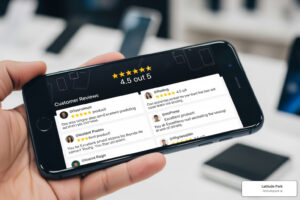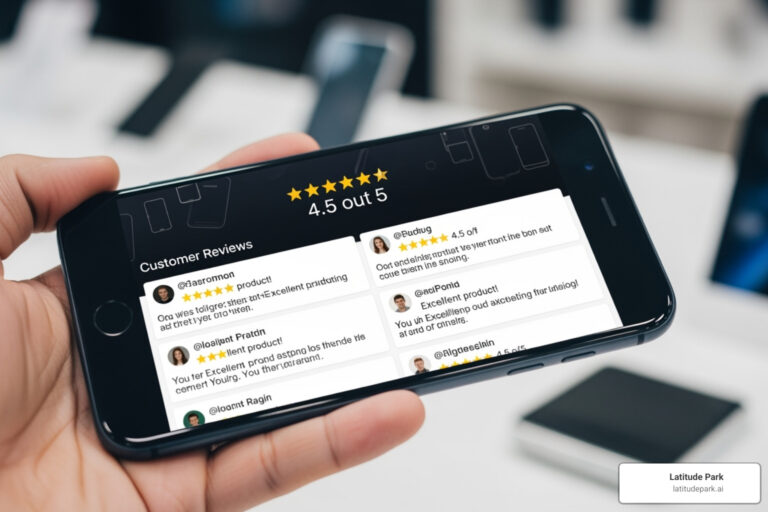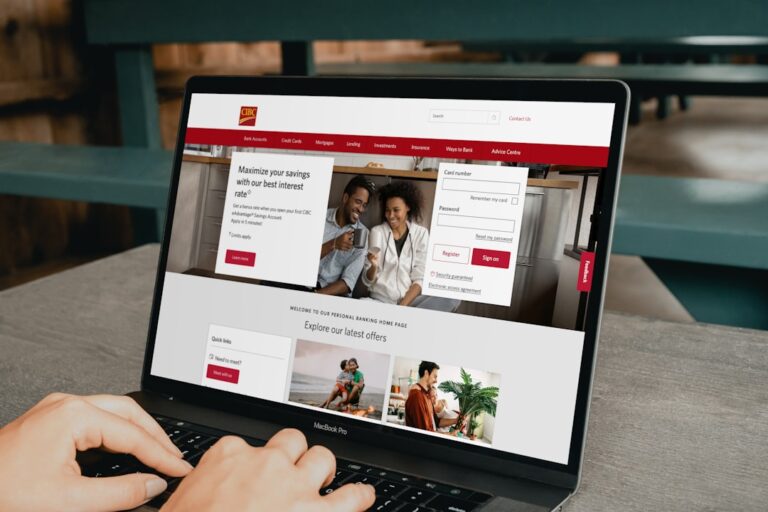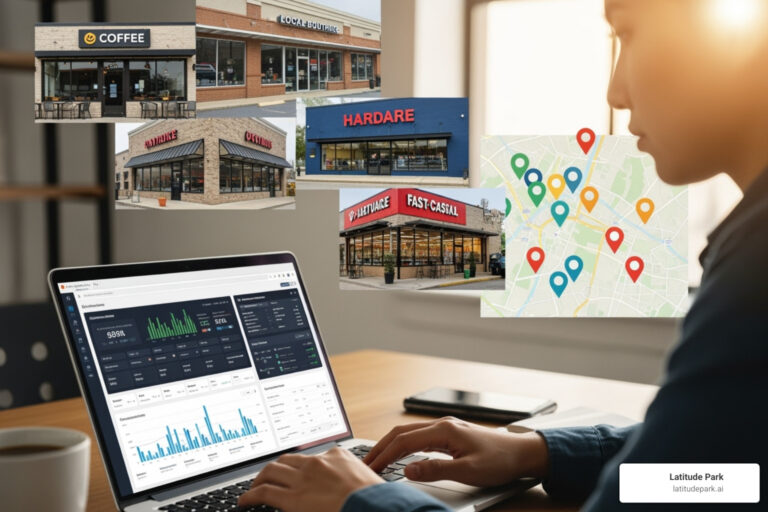A local directory listing is your business's public profile on platforms like Google, Yelp, and other industry-specific sites. But it's so much more than just a name and number.
Think of it as your digital welcome mat—often the very first interaction a potential customer has with your brand before they ever click to your website or walk through your doors.
Why Your Local Directory Listing Is Your Digital Welcome Mat
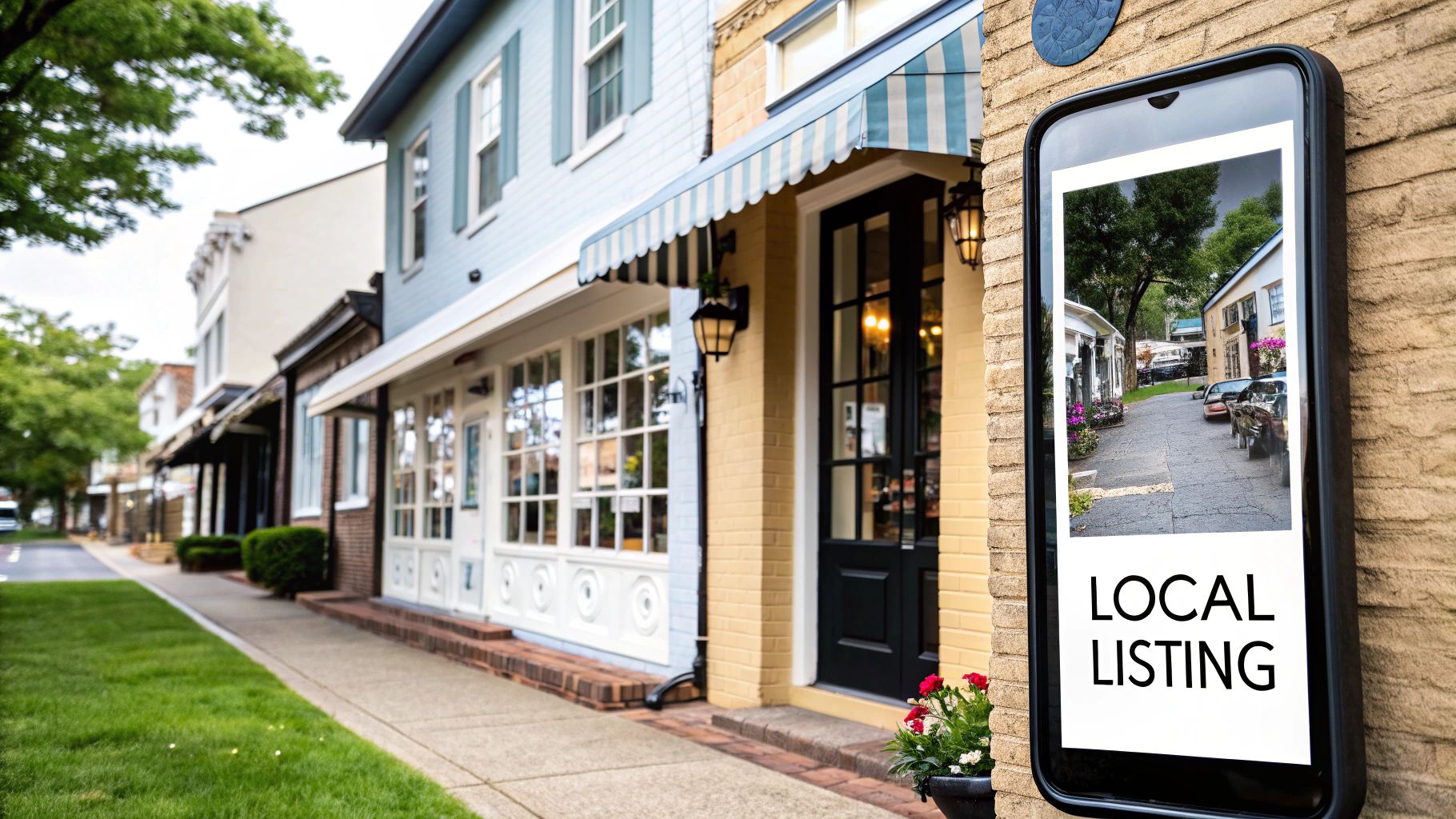
Forget those dusty, yellowed phone books that ended up as doorstops. A modern local directory listing is a dynamic, interactive storefront that real customers use every single day to find, evaluate, and get in touch with businesses just like yours. It’s not just an entry in a database; it’s a living, breathing tool that builds trust and drives actual foot traffic.
When someone searches for "plumbers near me" or "best coffee shop," search engines and apps pull information directly from these listings to serve up the most relevant results. A complete, accurate, and rich profile sends a powerful signal to Google that your business is legitimate, active, and exactly what that searcher needs right now.
The Tale of Two Businesses
To really see the impact, picture two competing local shops:
- Business A (The Ghost Town Listing): It has a name, an old phone number that might not work, and no business hours. There are zero photos, and the description is blank. Practical Insight: A potential customer searching for "emergency roof repair" sees this listing and immediately thinks, "Are they even open? I can't risk it." They scroll right past.
- Business B (The Vibrant Profile): This listing has the correct name, address, and phone number (NAP). It's filled with vibrant photos of its products and happy customers, a detailed description of services, up-to-date hours, and dozens of glowing reviews. Practical Insight: The same customer sees this listing, which features photos of a recent storm damage repair and a review from yesterday praising their fast response. The customer calls immediately, confident they've found a reliable professional.
The difference is night and day. Business B will almost always win that customer's click and their business. And it’s not just a hunch; the data backs this up. Research shows approximately 76% of consumers turn to online directories to find local businesses.
Even more telling, businesses with rich, complete profiles get up to 520% more views than those with just the basics. It's a massive difference.
A well-maintained local directory listing does more than just provide information—it builds confidence. Every photo, review, and accurate detail tells a potential customer that you care about your business and, by extension, them.
In the end, neglecting your local directory listings is like locking the front door of your digital storefront and expecting customers to find a way in. It's a non-negotiable part of modern marketing for any business that wants to be found by people in its community. Understanding why your local business listing is essential is the first critical step toward attracting more of the right customers.
The Building Blocks of a Powerful Listing
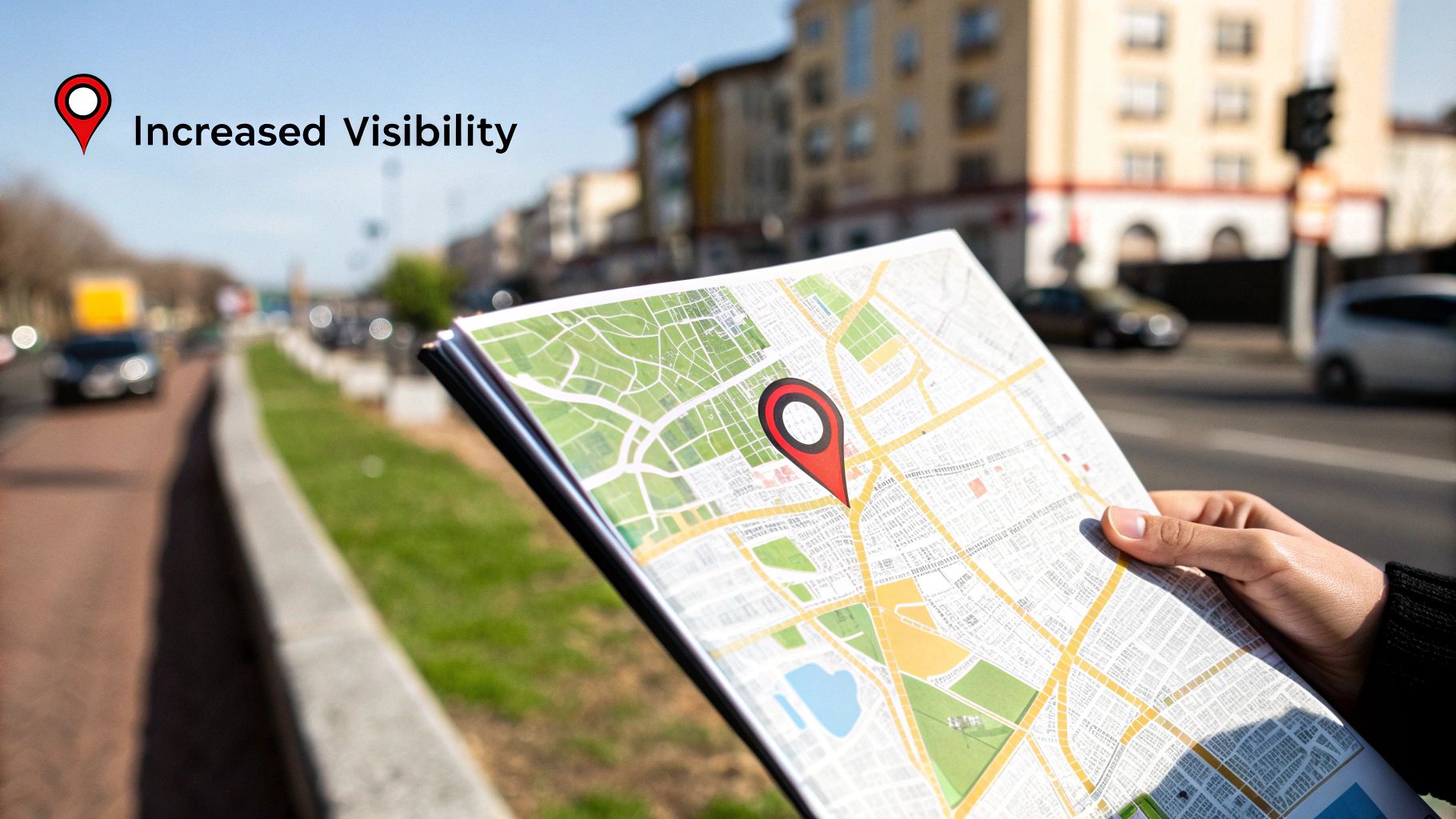
A truly effective local directory listing is built on a few core, non-negotiable pieces. Think of these as the foundation of your digital storefront. If any part is weak or cracked, the entire structure becomes less trustworthy to both potential customers and search engines like Google.
At the very heart of this foundation is NAP consistency. This isn't just industry jargon; it’s the bedrock of your local presence. It stands for your business's Name, Address, and Phone number. These three details must be absolutely identical everywhere they appear online, from major directories to your own website.
Imagine giving a friend two slightly different addresses to meet you for lunch. One says "123 Main St." and the other "123 Main Street, Suite A." That small difference creates confusion and a lack of trust. Search engines feel the same way. They see inconsistent NAP information as a major red flag, which can hurt your credibility and tank your ranking in local search results.
Beyond the Basics of NAP
While a consistent NAP is the cornerstone, a powerful listing needs more to truly capture a customer's attention. These additional details turn a simple entry into a compelling mini-advertisement for your business.
-
Precise Business Categories: Choosing the right categories is crucial. It’s how you connect with customers who know exactly what they want. Practical Example: A bakery shouldn't just list itself as "bakery." Adding "cupcake shop," "wedding cakes," and "gluten-free baked goods" helps it appear in front of customers searching for those specific services. Be specific to attract your ideal buyer.
-
Compelling Business Description: Your description is your digital elevator pitch. This is your chance to tell your story, highlight what makes you unique, and weave in keywords that your customers are searching for. Practical Example: Instead of a flat "We sell coffee," try something like, "Your neighborhood artisan coffee shop, serving ethically sourced, single-origin espresso and fresh, locally baked pastries daily. Your cozy spot for remote work or catching up with friends."
A significant part of building a powerful listing involves understanding how to effectively start by optimising your Google Business Profile, which is often the first point of contact for local customers.
To make sure you're covering all your bases, here’s a quick checklist of the essential components that every optimized directory listing should have.
Essential Components of an Optimized Directory Listing
| Component | Description | Why It's Critical |
|---|---|---|
| Consistent NAP | Your business Name, Address, and Phone number are identical everywhere. | Builds trust with search engines and prevents customer confusion. |
| Website Link | A direct, working link to your business's official website. | Drives traffic and allows customers to learn more about your brand. |
| Accurate Business Hours | Your current opening and closing times, including holiday and special event hours. | Prevents customer frustration and lost sales from incorrect information. |
| Precise Categories | Specific, relevant categories that describe exactly what you offer. | Helps you appear in hyper-specific searches from ready-to-buy customers. |
| Compelling Description | A unique, keyword-rich summary of your business and its story. | Your chance to stand out from competitors and connect with your audience. |
| High-Quality Photos | Clear, professional images of your products, space, and team. | Builds an emotional connection and sets customer expectations. |
| Customer Reviews | A steady stream of authentic reviews from your customers. | Provides social proof and heavily influences purchasing decisions. |
Think of this table as your pre-flight checklist. Getting these elements right ensures your listing is ready to attract, inform, and convert potential customers.
Completing the Picture for Customers
Finally, a few more details complete your profile, turning it from a simple listing into a genuinely useful tool for anyone who finds it.
First, high-quality photos and videos are absolutely essential. Don't just tell people about your business—show them. Practical Insight: Post pictures of your products, your welcoming space, your friendly team, and even happy customers (with their permission, of course). A landscaping company could post a 30-second video walkthrough of a finished garden project. These images tell a story far more powerfully than words alone, building an emotional connection before a customer even steps through your door.
Second, always maintain accurate business hours. Seriously. Nothing frustrates a potential customer more than driving to your business only to find it closed because your listing had outdated information. Practical Example: If a snowstorm forces you to close early, update your Google Business Profile hours immediately. Customers will see a real-time update, saving them a trip and building trust in your reliability.
Together, these building blocks create a robust and trustworthy local directory listing that works hard for your business, 24/7.
Choosing The Right Directories For Maximum Impact
Trying to get your business listed on hundreds of random online directories is a fast track to burnout. It's like trying to catch fish by casting a massive net into an empty part of the ocean. You'll spend a ton of energy but come up with nothing. The real key to a powerful local directory strategy isn't volume—it's precision.
This means putting your effort where it counts most: on the platforms where your ideal customers are actually looking for you. A strategic approach ensures every minute you invest in your listings pays you back. The goal is to be present where it matters, not just to be everywhere.
The Three Tiers Of Local Directories
To make this easier, I like to break down directories into three main groups. Each one plays a unique and vital role in making sure local customers can find you.
-
Tier 1: The Titans
These are your non-negotiables. Think of them as the foundation of your entire online presence. This small but mighty group includes giants like Google Business Profile, Apple Maps, and Bing Places. Practical Insight: A listing here is absolutely essential because these platforms power the default map and search apps on nearly every smartphone and computer out there. Fail here, and you're invisible to a huge portion of local searchers. -
Tier 2: The Major Hubs
This next layer is made up of the big, high-traffic aggregators that customers know and trust for reviews and business info. We're talking about household names like Yelp and the online Yellow Pages. They cast a wide net and often pop up high in search results themselves, giving you another solid chance to get discovered. -
Tier 3: The Specialists
This is where the real strategic magic happens. These are the niche, industry-specific directories that attract a super-motivated audience. Practical Example: For a home renovation contractor, a profile on Houzz is a goldmine. For a restaurant, being on TripAdvisor with great reviews is a must. For a wedding photographer, a listing on The Knot is non-negotiable.
This diagram breaks down the core elements you have to get right on any platform to make your listing work for you.
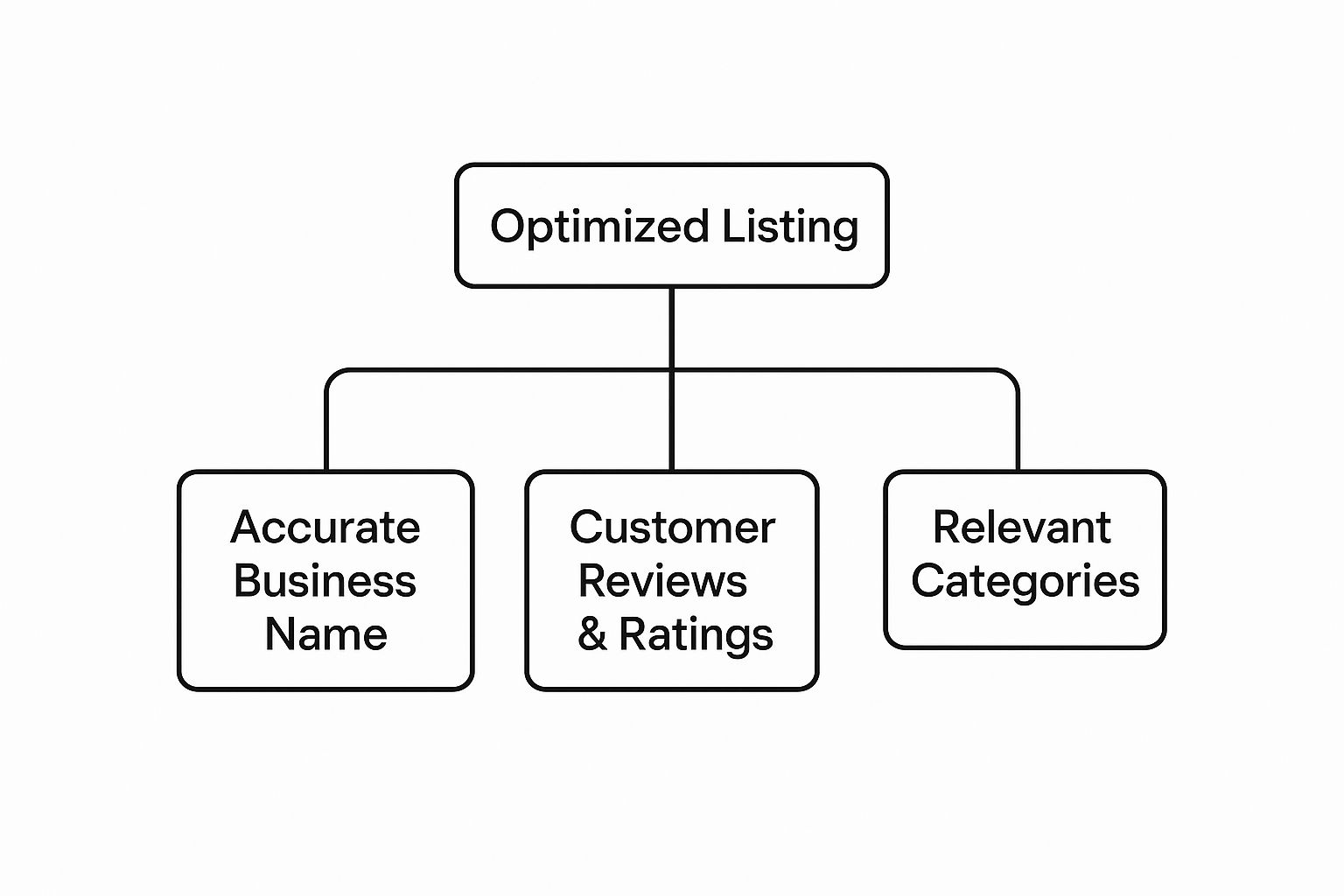
As you can see, getting the basics right—like an accurate business name, a steady stream of customer reviews, and the correct business categories—is fundamental to your success.
Identifying Your High-Impact Platforms
So, how do you uncover those high-impact specialist directories for your business? Simple. Start by putting yourself in your customer's shoes. Where would they go online to find a business like yours?
Practical Example: A local law firm will get far more valuable leads from a polished profile on Avvo or FindLaw than from a dozen generic business sites. To find these, simply Google search phrases like "best [your industry] directory" or "[your service] review site." The top results will often be your industry's most important niche platforms. You can learn more about the advantages of using local directories for your business.
A powerful local directory listing strategy isn’t about volume; it’s about relevance. Being listed on five high-impact directories where your customers live is infinitely more valuable than being listed on 100 irrelevant ones.
As you build your list, checking out resources like these 12 free business listing sites can give you some great ideas for your specific industry or area.
By focusing your energy on these high-value platforms, you're not just throwing information out there and hoping it sticks. You're connecting directly with customers who are actively searching for what you offer, which is what ultimately drives more qualified leads and foot traffic right to your door.
How Listings Fuel Your Local SEO Engine
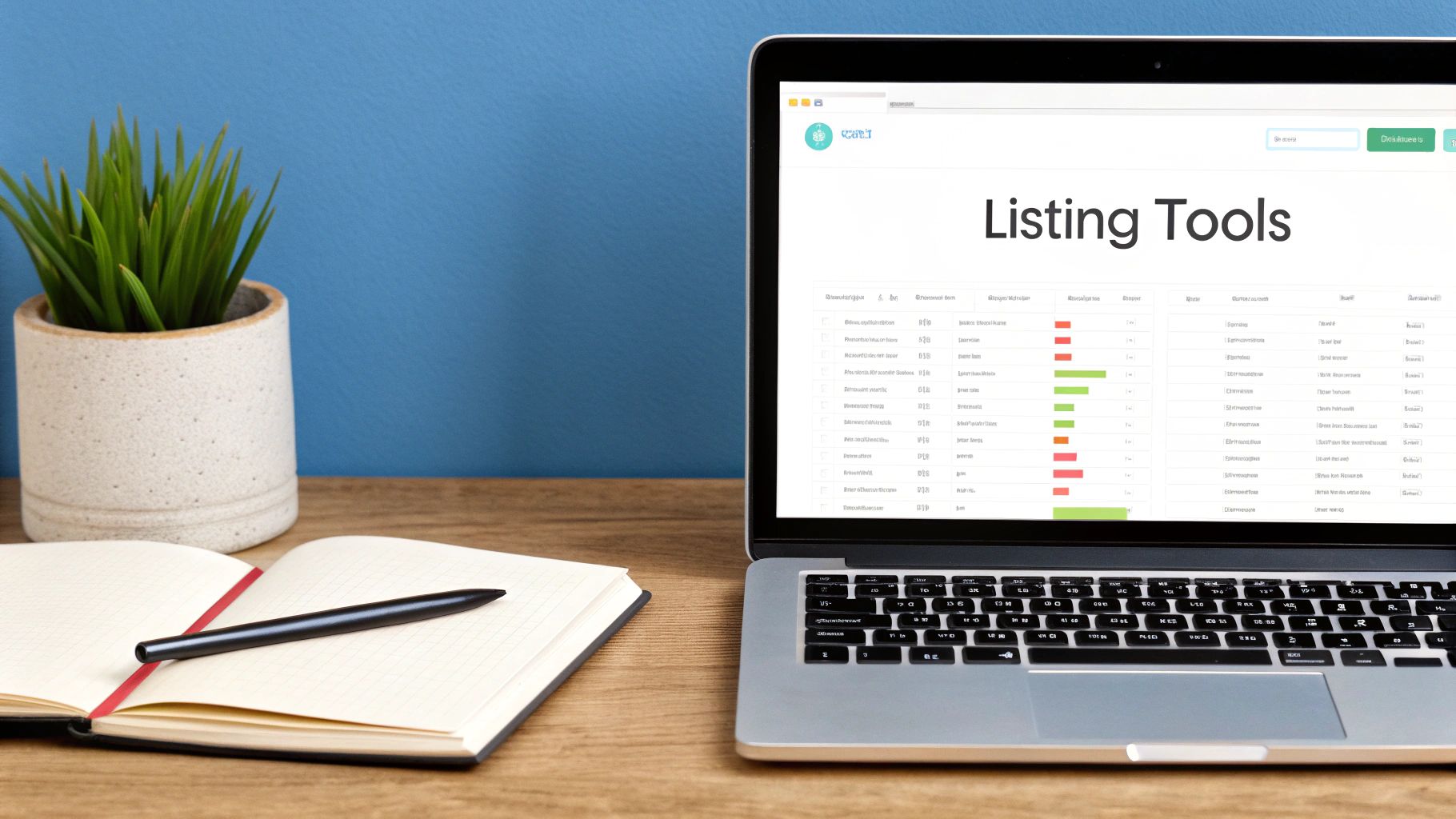
It’s time to connect the dots. You’ve got a sharp-looking local directory listing, but how does that actually help you show up in search results? While a great listing definitely impresses customers, its real power is how it directly fuels your local Search Engine Optimization (SEO).
Think of it as one of the most straightforward ways to tell search engines like Google, "Hey, we're a real, legitimate business right here at this address!" Each accurate listing you create is like a vote of confidence for your business.
When Google’s crawlers see your correct business name, address, and phone number (NAP) repeated consistently across trustworthy directories, it’s like getting a reference from a trusted friend. These consistent mentions, known in the SEO world as citations, are a bedrock signal of credibility.
Turning Trust Signals into Search Rankings
Every single quality citation you earn strengthens your online authority. This authority is what directly impacts your chances of landing in the coveted Google Local Pack—that all-important box with a map and three business listings right at the top of the search page.
Practical Example: When someone searches for "emergency dentist near me," Google doesn't just take a wild guess. Its algorithm zips across the web, looking for the most reliable, relevant, and prominent local businesses to recommend. A business with dozens of consistent citations on platforms like Yelp, Bing, and dental-specific sites like Healthgrades will almost always outrank a competitor with spotty or incorrect information.
The impact is huge. In fact, research shows that a staggering 92% of SEO experts view accurate business listings as a foundational ranking factor. Consistency in your NAP data alone influences 27% of local ranking signals, making it a massive piece of the local SEO puzzle.
More Than Just NAP Citations
While consistent citations are the engine, customer interactions are the high-octane fuel that makes it go. Modern directories are about much more than just data; they're dynamic platforms for engagement.
- Customer Reviews: Every new review, especially a positive one, tells search engines your business is active and valued by its community. Practical Insight: When customers use keywords in their reviews, like "The best deep-dish pizza in Chicago," it can actually help you rank for those specific terms.
- Questions and Answers: The Q&A feature on profiles like Google Business Profile is a goldmine. When you answer common questions, you're creating highly relevant content that directly matches what people are searching for. Practical Example: An auto repair shop can pre-emptively answer "Do you work on foreign cars?" or "Is there a charge for an estimate?" This saves customers time and signals expertise to Google.
A local directory listing isn't a static phonebook entry; it's an active SEO asset. Each consistent citation acts as a verifiable proof point for search engines, while every customer review and answered question adds another layer of relevance, making it easier for new customers to find you.
This ripple effect is precisely why a strong directory presence is a cornerstone of any effective local SEO strategy. You can go deeper by learning how to start optimizing your website for local search results.
To make sure you've got all your bases covered, following an ultimate local SEO checklist can help you optimize every aspect of your local listings for maximum impact.
Keeping Your Listings Fresh and Engaging
A local directory listing is not a "set it and forget it" task. Far from it. Think of it like a garden; once you've planted the seeds, it needs ongoing care to thrive. A neglected listing can quickly become overgrown with inaccurate information, which is a major turn-off for potential customers who value what’s current and relevant.
Treating your listings as living, breathing profiles is the only way to win in the long run. They need regular attention to stay accurate, engaging, and effective at bringing people through your door. This constant management signals to both customers and search engines that you’re an active, reliable, and trustworthy business.
Conduct Regular Listing Audits
The first step in maintaining a healthy online presence is to regularly audit your listings. Over time, inaccurate or duplicate listings can sprout up across the web like weeds, creating confusion and damaging your credibility. This often happens without you even knowing it, thanks to automated data aggregators or old marketing efforts.
A simple audit just means searching for your business on major platforms and playing detective. Look for anything that seems off.
- Check for Duplicates: Search for your business on Google Maps and Yelp. Do multiple versions pop up? If so, you need to take steps to claim and either merge or remove the duplicates.
- Verify NAP Consistency: Is your Name, Address, and Phone number identical across all your key listings? Practical Insight: Check for subtle differences like "St." vs. "Street," or "LLC" being present in one name but not another. These tiny variations can cause problems for search engines.
- Review All Details: Check everything else—your website link, business hours, photos, and service descriptions—to make sure they’re all up to date.
You should get in the habit of doing this at least quarterly. It’s the best way to catch errors before they do any real harm. A clean, consistent presence is fundamental to building trust.
Master the Art of Review Management
Customer reviews are one of the most dynamic—and powerful—parts of your local directory listing. How you handle them speaks volumes about your customer service. The key here is to respond to every review, both the glowing ones and the painful ones.
A prompt and professional response to a negative review can actually turn an unhappy customer into a loyal advocate. Practical Example: If a customer leaves a 1-star review complaining about a long wait, a good response would be: "Hi [Customer Name], we're so sorry you had to wait longer than expected. We were short-staffed today but that's no excuse. We'd love to make it right. Please contact us at [email/phone] so we can offer you a discount on your next visit." This shows all the other potential customers watching that you listen to feedback and are committed to making things right.
Responding to reviews isn't just customer service; it's public relations. Every reply is a chance to demonstrate your brand's values to a wide audience of prospective customers who are watching how you engage.
Use Directory Features to Your Advantage
Modern directories are packed with tools that let you proactively share updates and engage with your audience. Using these features keeps your profile fresh and gives customers a reason to check back in.
- Google Posts: Share updates about sales, events, new products, or even your latest blog articles directly on your Google Business Profile. Practical Example: A local boutique could create a post showcasing its new spring collection with a "15% off this week" call to action. These posts are temporary and highly visible, making them perfect for time-sensitive promotions.
- Q&A Sections: Don't wait for customers to ask questions. Proactively populate the Question & Answer section on platforms like Google. Add the common questions you get all the time and provide clear, helpful answers. Practical Example: A gym can answer questions like "Do you offer childcare?" or "What are your peak hours?" This saves your customers time and positions you as the expert.
- Update Holiday Hours: This is such a simple but critical task. Failing to update your hours for an upcoming holiday is a surefire way to frustrate a customer who makes a wasted trip to your closed storefront.
Manual Management vs. Software
As a business owner, you have two main ways to tackle this: do it all yourself by hand, or use a listing management tool to lighten the load.
| Approach | Pros | Cons |
|---|---|---|
| Manual Management | No cost, full control over each platform. | Extremely time-consuming, difficult to scale, easy to miss listings. |
| Management Software | Saves significant time, ensures consistency across dozens of sites, provides centralized analytics. | Comes with a monthly or annual subscription fee. |
Practical Insight: For a business with just a handful of core listings (like a single-location coffee shop focusing on Google and Yelp), a manual approach can work just fine. But if you're a franchise with 10 locations, or a service business aiming for visibility across 20+ directories, management software quickly becomes an indispensable tool for keeping your presence accurate and engaging.
The Future of Local Search and Your Business
If you want to stay ahead of the competition, you need to understand where local directory listings are heading. Local search isn't standing still; it's getting smarter, faster, and more woven into the fabric of our daily lives. Getting ready for these changes is the only way to make sure your business stays visible and relevant.
The future is really being molded by two major forces: artificial intelligence and voice technology. AI is already being used to automatically spot and flag outdated information, helping platforms like Google and Yelp self-correct. This rewards businesses that keep their content accurate and fresh. What this means for you is that maintaining your listing is no longer just a "best practice"—it's quickly becoming a non-negotiable for getting seen.
Voice Search and Transactional Listings
Think about it. When a customer asks Alexa or Siri, “Where’s the nearest coffee shop that’s open now and has Wi-Fi?” that answer is pulled straight from local directory data. These voice assistants depend on structured, accurate information to give an instant, reliable answer. If your business hours are wrong or your address is inconsistent, you simply won't be an option.
This massive shift toward conversational search makes a perfect local directory listing more critical than ever before.
Another huge trend is the move toward transactional features. Customers don't just want to find information anymore; they expect to take action right away, directly from the listing. This includes things like:
- Direct Booking: A customer can book an appointment or make a reservation without ever leaving the search results page.
- Ordering and Quotes: A restaurant can let customers order food directly, or a contractor can offer instant quotes through their listing.
- Messaging: Real-time chat features can connect customers straight to the business for quick questions.
Your local directory listing is evolving from a static online business card into an interactive, full-service concierge. It’s not just about getting found anymore; it’s about being ready to do business the second you're discovered.
The market is already reflecting this growing importance. The global market for directories and mailing list services is set to grow from $36.82 billion in 2024 to an estimated $38.07 billion in 2025. You can discover more insights about the local directory market to get a better sense of its trajectory. By leaning into these trends, you're not just setting up your business for today's searches, but for tomorrow's customers.
Here is the rewritten section, crafted to match the human-written style and expertise demonstrated in the provided examples.
Your Local Directory Questions Answered
Ever wonder how local directory listings actually work in the real world? It's a common area of confusion for business owners. Let's tackle some of the most frequent questions I hear, so you can move forward with a clear strategy.
How Long Until I See Results?
This is the big one everyone asks. While quick fixes like updating your hours on a Google Business Profile can show up in just a few days, the real SEO magic takes a bit longer.
Practical Insight: Think of it like building a reputation. It doesn't happen overnight. It typically takes several weeks to a few months for search engines to fully recognize and trust your updated information across all the different directories. A brand new business claiming listings for the first time might see an impact in 3-4 months, while an established business correcting inconsistencies might see improvements in 6-8 weeks. Consistency is your most powerful tool here, and a little patience goes a long way.
Should I Pay for Premium Listings?
It depends. Your first priority should always be mastering the free listings on the powerhouse platforms like Google and Bing—they're incredibly effective and cost you nothing.
Paid or premium listings can be a smart move, but only on high-traffic, niche directories where you know your ideal customers are already hanging out. Practical Example: A premium listing on Yelp might allow a restaurant to add a call-to-action button or a video, which could be worth the investment. However, paying for a premium spot on a generic, low-traffic directory is likely a waste of money.
Before you spend a dime, really dig into the directory's relevance and potential return on investment. For most businesses, getting the free listings perfect is the strongest foundation you can build.
What Is the Biggest Listing Mistake?
The most common and damaging mistake I see is NAP (Name, Address, Phone Number) inconsistency. It sounds simple, but even tiny variations across platforms can throw a wrench in your efforts.
Practical Example: A business is listed as "Joe's Pizza" on Google, "Joe's Pizzeria LLC" on Yelp, and "Joes Pizza" on Facebook. One listing has the old address from before they moved. This all creates confusion for customers and, more importantly, for search engines. This confusion directly torpedoes your local SEO authority and chips away at your business’s credibility. It’s the number one thing to get right.
Ready to stop guessing and start growing? Latitude Park specializes in fine-tuning your local SEO and managing your digital presence so you can focus on what you do best. Let us turn your listings into a powerful engine for customer growth. Discover how our SEO services can help your business.

